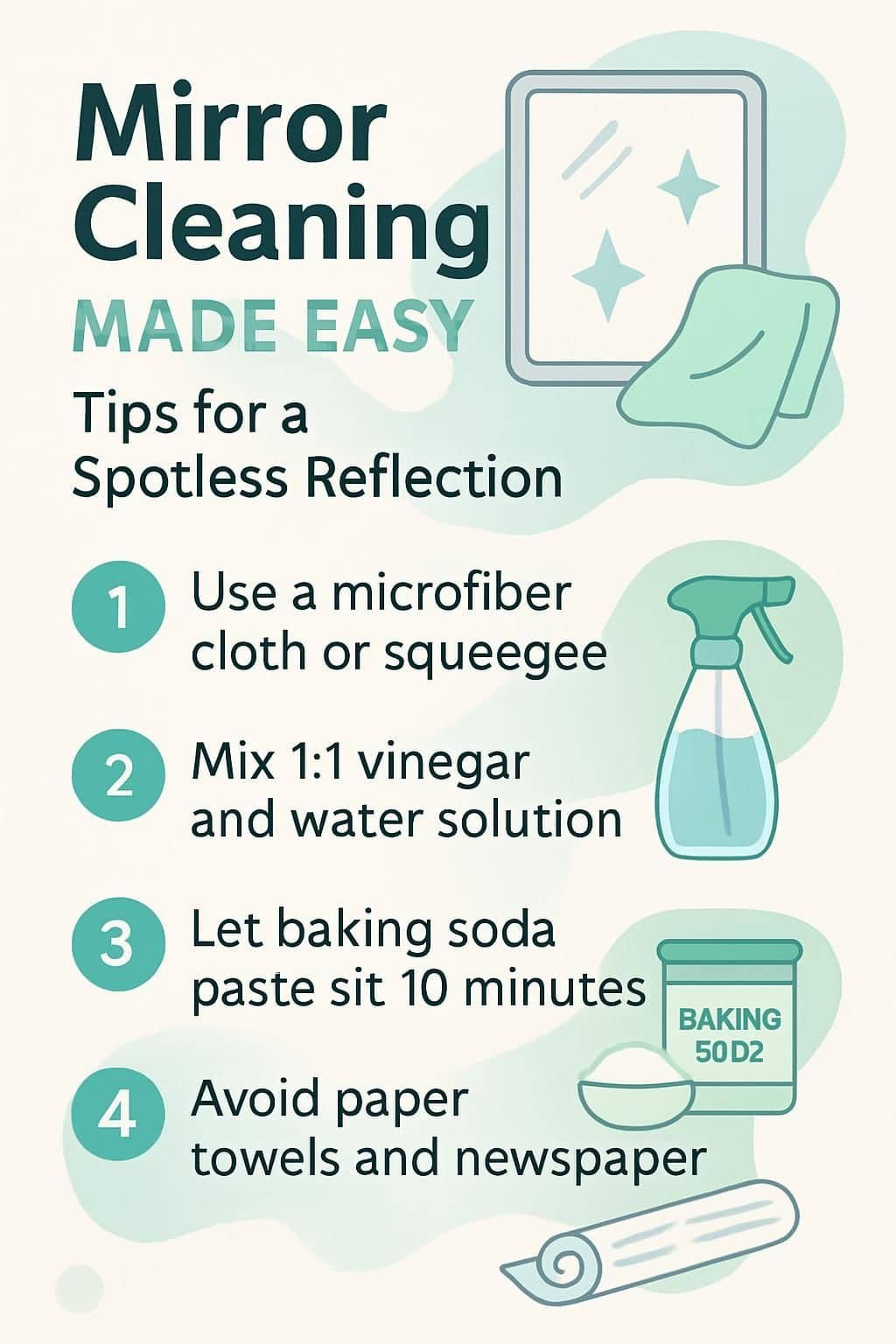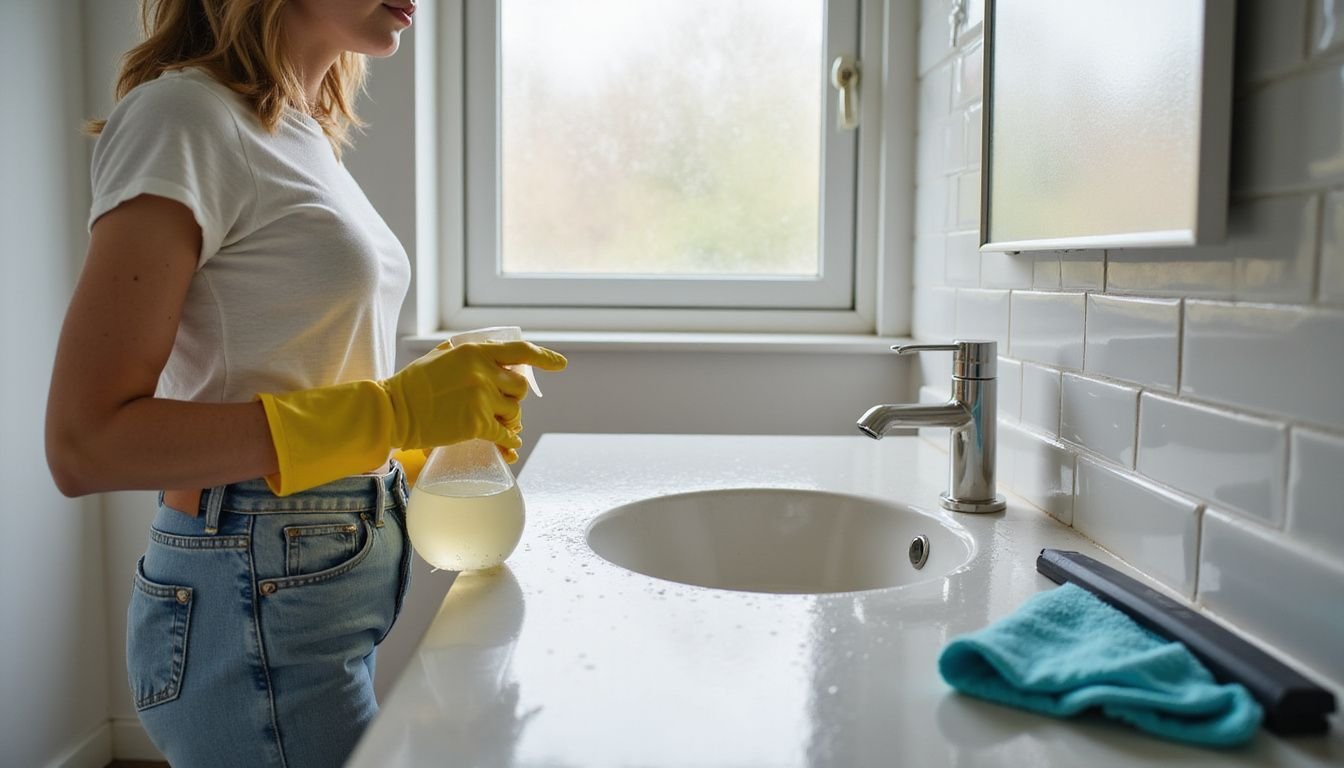Smudges and streaks can make any mirror look dirty, no matter how often someone cleans it. Many homeowners and parents find that getting a spotless reflection is harder than it seems.
Using the wrong cleanser or a paper towel can leave behind even more marks. These common mistakes can make the surface appear dull instead of shiny.
Experts agree that glass is best cleaned with the right tools and a gentle approach. A microfiber cloth or a squeegee works better than regular towels or tissues. Simple solutions like vinegar mixed with water can help keep the surface clear and streakfree.
In this blog, readers will find out How To Cleaning A Mirror the right way, from removing dust to polishing for a brilliant shine. Discover easy tips below to make every reflection sparkle.
Key Takeaways
- Use a microfiber cloth or squeegee for cleaning. These tools leave fewer streaks and do not scratch the glass.
- Mix equal parts vinegar and water in a spray bottle. This solution cleans grime from mirrors without leaving residue.
- Baking soda paste removes tough hard water stains. Apply the paste, let it sit for 10 minutes, then rinse and wipe dry.
- Avoid paper towels and newspaper. They can leave lint and ink smudges on your mirror.
- Regular cleaning and keeping the bathroom air dry help prevent fog and streaks. Use an exhaust fan after showers.

Essential Tools and Materials for Mirror Cleaning

Moving on from the introduction, getting the right tools and materials is crucial for effective mirror cleaning. House owners and parents will find that having these items on hand makes the process smoother.
- Microfiber cloths: These cloths are gentle on mirrors and do not leave lint behind, making them perfect for a streak-free shine.
- Vinegar: A natural cleanser, vinegar works well with water to cut through grime without leaving harmful residues.
- Water: Used with vinegar or as a rinse, distilled water is best as it doesn’t leave mineral deposits behind.
- Spray bottle: This tool helps evenly distribute your vinegar solution across the surface of the mirror.
- Squeegee: Essential for removing all solution from the mirror surface to prevent streaks and ensure a thorough clean.
- Baking soda: For tough stains, especially hard water marks, baking soda mixed into a paste can be very effective.
- Rubber gloves: They protect your hands from drying out due to cleaning solutions and can give you a better grip on your tools.
- Soft toothbrush or cotton swabs: These are great for getting into the corners and around the edges of the frame where dust collects.
- Commercial glass cleaner: In case you prefer not making your own solutions, choosing an ammonia-free glass cleaner is advisable for safety and effectiveness.
Each of these items plays an essential role in keeping mirrors spotless and reflecting beautifully without much effort.https://www.youtube.com/watch?v=Nt7FIKftkDE
Preparing Your Mirror for Cleaning
Preparing a mirror for cleaning starts with dusting the frame and surface. Use a microfiber cloth to trap dust effectively and avoid scratches on the glass.
Dusting and Cleaning the Frame
House owners and parents often overlook the frame when cleaning mirrors. Yet, a clean frame is essential for a spotless reflection.
- Start by gently dusting the frame with a soft, lint-free cloth. This removes loose dust without scratching the surface.
- Use a small brush or vacuum cleaner with a soft brush attachment to get into crevices and detailed parts of the frame.
- Mix a mild soapy water solution for frames that can handle moisture. Apply this solution using a microfiber cloth, being careful not to let any liquid seep behind the mirror glass.
- For wooden frames, consider using wood polish after cleaning to enhance their shine and protect them from damage.
- Metal frames might need a specific cleaner based on the type of metal. Use brass cleaner for brass frames or silver polish for silver ones, applying with a soft cloth.
- Wipe down the frame with a dry microfiber cloth after cleaning to remove any remaining moisture and prevent streaks.
- Check for any signs of damage such as chips or cracks during cleaning. Address these areas promptly to prevent further deterioration.
These steps ensure both the mirror and its frame remain in pristine condition, reflecting care and attention in your home’s maintenance routine.
Avoiding Common Mistakes
After dusting and cleaning the frame, many people rush straight to spraying cleaner onto the glass. Spraying solution directly often causes drips that run behind the frame and damage surfaces.
Instead, spray a small amount onto a microfiber cloth or lintfree cloth for better control and less mess.
Using rough paper towels or old rags leaves scratches on glass. Soft microfiber cloths work best because they lift dust and dirt without harming the reflection or shine. Skipping a rinse with clean water can also leave streaks, so always wipe with a damp, streakfree cloth before a final polish.
Too much vinegar or harsh cleaning solutions may cause cloudiness; measure your solution to avoid damaging your mirror’s surface care. Squeegees provide a streakfree finish, especially for large mirrors, helping families keep reflections spot-free with less effort.
Effective Cleaning Techniques
Effective cleaning techniques make a huge difference in achieving spotless mirrors. A vinegar and water solution works great for cutting through grime, while a baking soda paste tackles tough water stains with ease.
Vinegar and Water Solution
Mix vinegar with water in a spray bottle for an effective cleaning solution. Combine one part vinegar with one part water. This simple mixture cuts through grime and leaves mirrors sparkling clean.
Spray the solution directly onto the mirror’s surface. Use a microfiber cloth to wipe away dirt and smudges. For best results, work from top to bottom. Avoid using paper towels as they can leave lint behind.
With this vinegar and water solution, achieving a streak-free reflection becomes effortless.
Baking Soda Paste for Hard Water Stains
Baking soda paste works wonders for hard water stains on mirrors. Combine baking soda with a little water to form a thick paste. Apply this mixture directly onto the stained areas of the mirror using a soft cloth or sponge.
Gently rub in circular motions, allowing the paste to lift away stubborn deposits.
After scrubbing, let the paste sit for about 10 minutes. Rinse it off with clean water and dry the surface with a lint-free cloth or microfiber towel. This technique clears away hard water stains and leaves behind a shiny reflection without streaks.
Homeowners will appreciate how simple yet effective this method is for maintaining spotless mirrors.
Preventing Streaks and Haze
Use a microfiber cloth for cleaning. This prevents streaks and keeps the mirror’s surface looking clear. Avoid paper towels, as they often leave fibers behind. Create a vinegar and water solution in equal parts for effective cleaning.
Spray it onto the mirror, then wipe it gently with your cloth.
Always clean in straight lines or circular motions to ensure an even finish. Using a squeegee can also help eliminate excess moisture and prevent hazy spots that may form when water dries on glass surfaces.
Following these tips allows house owners and parents to maintain spotless reflections easily while keeping mirrors sparkling clean, setting the stage for effective maintenance techniques next.
Tips for Maintaining a Spotless Mirror
Maintaining a spotless mirror requires regular attention and care. Homeowners and parents can follow these practical tips to keep their reflections clear and shiny.
- Clean mirrors frequently. Regular cleaning prevents dust and dirt buildup on the surface, maintaining a pristine look.
- Choose the right cleaning solution. Vinegar mixed with water serves as an effective natural cleanser for removing grime without harming the glass.
- Wipe with a microfiber cloth. This lint-free cloth prevents scratches while ensuring a streak-free shine after cleaning.
- Avoid using newspaper for cleaning. While it once seemed popular, newspaper can leave ink smudges on mirrors, hindering clarity.
- Use a squeegee for larger mirrors. When cleaning big surfaces, a squeegee helps remove excess moisture quickly, preventing streaks from forming.
- Dust the frame regularly. A clean frame enhances appearance by removing any dust or debris that may detract from the mirror’s shine.
- Try to clean when light conditions are optimal. Natural light reveals streaks and imperfections better than artificial light so early mornings work well for this task.
- Avoid harsh chemicals that can damage reflective surfaces over time; stick to mild solutions that ensure long-lasting clarity.
- Keep bathroom air dry after showers; utilizing an exhaust fan reduces humidity, which minimizes fogging on mirrors while enhancing visibility.
- Do not forget about proper storage for sheets of glass or mirror coverings; storing them flat in a safe place avoids potential scratches or damage down the line.
Conclusion
Cleaning mirrors doesn’t have to be a hassle. With the right tools and techniques, anyone can achieve a streak-free shine. Using simple solutions like vinegar and water works wonders on surfaces.
Regular maintenance keeps mirrors looking their best. Follow these tips for an easy way to enjoy spotless reflections every day.
FAQs
1. What are some effective tips for cleaning mirrors?
To clean mirrors effectively, use a mixture of water and vinegar or a commercial glass cleaner. Apply the solution with a microfiber cloth to avoid streaks.
2. How can I prevent streaks when cleaning my mirror?
To prevent streaks, always wipe in a circular motion and dry the surface quickly after applying your cleaner. This helps ensure a spotless reflection.
3. What common mistakes should I avoid while cleaning mirrors?
Avoid using paper towels or rough fabrics that can scratch the mirror’s surface. Also, do not clean mirrors in direct sunlight as it can cause the cleaner to dry too fast.
4. Is there an easy way to maintain a clean mirror?
Yes, regularly dusting your mirror with a soft cloth will help keep it clean longer. Quick touch-ups every few days can also help maintain its pristine condition.


